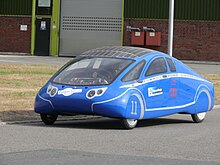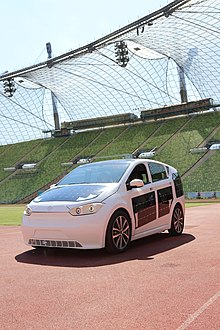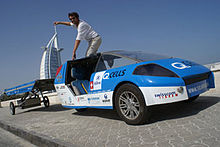List of prototype solar-powered cars: Difference between revisions
Rescuing 8 sources and tagging 1 as dead. #IABot (v1.6.1) |
No edit summary |
||
| Line 11: | Line 11: | ||
The "Solar Spirit 3" with 3 seats was built by [[Technical and further education|TAFE South Australia]] for the 2011 [[World Solar Challenge]]. |
The "Solar Spirit 3" with 3 seats was built by [[Technical and further education|TAFE South Australia]] for the 2011 [[World Solar Challenge]]. |
||
<ref>{{cite web|url=http://www.tafesa.edu.au/solar-car/solar-cars |title=Solar Cars |publisher=Tafe Sa |date= |accessdate=2013-10-07}}</ref> |
<ref>{{cite web|url=http://www.tafesa.edu.au/solar-car/solar-cars |title=Solar Cars |publisher=Tafe Sa |date= |accessdate=2013-10-07}}</ref> |
||
== Brazil == |
|||
=== e.coTech Solar version === |
|||
The "e.coTech" is a normal electric car developed by by "HiTech Electric" and is sold only to small and medium-sized businesses. In 2017, the solar version of "e.coTech" was annouced and presented to the public in 2018.<ref>{{cite web|url=http://hitech-e.com.br/blog/veiculo-eletrico-com-recarga-fotovoltaica-aqui-brasil.html |title=Veículo elétrico com recarga fotovoltaica aqui no Brasil. |publisher=HiTech Electric |date=2018-25-23 |accessdate=2018-25-02}}</ref> |
|||
== Canada == |
== Canada == |
||
Revision as of 17:24, 25 February 2018
This list of prototype solar-powered cars comprises multiperson, relatively practical vehicles powered completely or significantly by solar cells (panels or arrays, mounted on the vehicle) which convert sunlight into electricity to drive electric motors while the vehicle is in motion and have a homologation for public streets.
Australia
Sunswift V (eVe)

The Sunswift V (aka "eVe") from the University of New South Wales was built for the 2013 & 2015 World Solar Challenge. [1]
Solar Spirit 3
The "Solar Spirit 3" with 3 seats was built by TAFE South Australia for the 2011 World Solar Challenge. [2]
Brazil
e.coTech Solar version
The "e.coTech" is a normal electric car developed by by "HiTech Electric" and is sold only to small and medium-sized businesses. In 2017, the solar version of "e.coTech" was annouced and presented to the public in 2018.[3]
Canada
Schulich Delta
The "Schulich Delta" from the University of Calgary was built for the 2013 World Solar Challenge. [4]
China
Cars without name
The handicraft enthusiast "Chen Shungui" developed 2 prototypes. [5]
Germany
Hochschule Bochum: Open World

The solar vehicle was built in 2015 from the "Hochschule Bochum" to cross the desert of Tanami in Australia. Range with fully charged accumulator is 50 kilometers. The car have a solar roof with 160 Wp and in a box below the roof (not on the picture) 1943 Wp (!) solar panels for extension during driving breaks.
PowerCore SunCruiser

The "PowerCore SunCruiser" with 3 seats was built in 2013 by "Hochschule Bochum". [6] Maximum Power created on his solar roof is 833 Wp. Car is equipped with 4 wheel hub electric engines. Participant on the World Solar Challenge 2013.
Sion

The Sion model from Sono Motors was presented to the public in July 2016. Two prototypes were financed by crowdfunding and were available for test drives in August 2017. The price will be EUR 16,000,- plus the battery you can rent or buy (<EUR 4.000, -). Pre-orders are available through the website[7] of Sono Motors. Delivery is scheduled to start in the 3rd quarter of 2019.
The car has 5 doors, an 80kW engine with a maximum speed of 140 km/h, is rechargeable with AC power (3.7 kW or 22 kW) and direct current (50 kW). The battery will have a realistic range of 250 km.
The solar cells (1.208 Wp) integrated into the car body charge the battery so that, in good sunshine, up to 30 km of additional range per day are possible.
It is possible to use the current of the battery in the Sion to operate electrical devices or to charge other electric cars.
The workshop manual for the Sion including the CAD data of all spare parts for 3D printers or CNC Milling will be public, so that reasonable repair costs are to be expected.
The owner of the vehicle can offer other people a power supply (power-sharing) or a ride-in (ridesharing) or rent his car (car sharing).
SolarWorld GT
The 2-seater "SolarWorld GT" was built 2011 by "Hochschule Bochum" with 2 wheel hub electric engines in the front wheels. After the participation at the 2011 World Solar Challenge, the car and his team did the first full autarky world circumnavigation (10/2011-12/2012).[8] This record was admitted by Guinness World Records. [9] On the roof of the car are 3 m² solar cells and in the trunk additional 3 m² which are used during driving breaks. Maximum power creation of all solar cells is 1340Wp. More technical data can be found here:.[10]
ThyssenKrupp SunRiser

"The "PowerCore SunCruiser" with two seats was built by "Hochschule Bochum" for the 2015 World Solar Challenge. [11] Maximum Power created on its 3 m² solar roof is 870 Wp. Car is equipped with 2 wheel hub electric engines and comfort electronics. Top speed is 120 km/h. Range with solar charging only is up to 600 kilometers per day. Range with fully charged accumulator (14,8 kWh) is up to 1100 kilometers.
India
SolarMobil
The team SolarMobil from the Manipal University built a prototype 2-seater solar passenger car called "SERVe" in 2015.
Italy
P-Mob
With an EU - project led by Fiat (May 2010 - April 2013) a complete solar car with 3 seats was developed. This small car have four wheel drive. Range with solar charging only is 20 kilometers per day. Range with fully charged accumulator is 120 kilometers. Homologation and serial production is under investigation (as of September 2013).[12]
Japan

Kaiton II
The "KAITON II" from the "Goko High School" was built for the 2013 World Solar Challenge. [13]
OWL
"OWL" was built for the 2015 World Solar Challenge in the Cruiser class by Kogakuin University.[14]
Monaco
Venturi Astrolab

"Venturi Automobiles" is building the open 2-seater "Astrolab" since 2006. Range with solar charging only is 18 kilometers per day. Range with fully charged accumulator is 110 kilometers. Top speed 120 km/h. [15]
Venturi Eclectic

"Venturi Automobiles" built the flanking not closed 3-seater "Eclectic" as prototype in 2006. Range with solar charging only is 7 kilometers per day. Range with fully charged accumulator is 50 kilometers. Top speed 50 km/h. Prices middle of the road was announced but serial production never started. There is also a small electric car with the name "Eclectic 2.0" from the same company existing. [16]
The Netherlands
Stella
The 4-seater "Stella" was built for the 2013 World Solar Challenge by Eindhoven University.[17] It was the winner in its class, and went on to win the crunchies award.[18]
Stella Lux
The 4-seater "Stella Lux" was built as successor of Stella for the 2015 World Solar Challenge by Eindhoven University.[19] It was the winner in its class again. With a top speed of 125 km/h and a European range of 1000 kilometers it is a substantial achievement with respect to common electric vehicles.
Stella Vie
In 2017 the Eindhoven team have built a new car for the World Solar Challenge, called Stella Vie, featuring five instead of four seats.
New Zealand
UltraCommuter
The "UltraCommuter" from the University of Waikato was built for the 2013 World Solar Challenge. [20]
Pakistan
ECO1, ECO1GL and ECO3GL
ECO1, ECO1GL and ECO3GL are built by a technology enthusiast and entrepreneur Muhammad Aslam Azaad. Built in March 2014.
Slovenia
Metron 7
A Mazda 5 was converted to an electric car named Metron 7 by Andrej Pecjak and his Metron team and in 2014 permitted for public use. Range with solar charging (160 Watt) is a few kilometers per day. Range with fully charged accumulator is 824 ! kilometers, proved from Berlin to Karlsruhe and through cities with average speed 72 km/h in June 2016.[21]
Superpiki
The project "Yuneec & Metron" convert a Smart Roadster to an electric car with 80 Wp solar panel in 2011. Range with solar charging only is a few kilometers per day. Range with fully charged accumulator is 160 kilometers. [22]
Switzerland
Icare
The project "Icare" build a Twike (Hybrid: muscular strength + electric engine) with an additional solar trailer (1800 Wp) and a small wind generator (diameter 1,8 m). With that vehicle they circumnavigate the world in 2010/11. [23]
Solar Taxi

This vehicle circumnavigate the world 2007/08 with "Lois Palmer" as driver. Energy was delivered to 50% from the solar trailer (6 m²) and to 50% from the power grid (which was indirectly produced by a solar installation in Switzerland). Power consumption: 8 kWh / 100 km. [24]
Taiwan
Apollo Solar Cruiser Car
The "Apollo Solar Car Team" from National Kaohsiung University of Applied Sciences build a solar car for the 2013 World Solar Challenge. [25]
USA
Daedalus
"Daedalus" of the University of Minnesota was built in 2013 for the World Solar Challenge.[26] It is currently on display at the PTC world headquarters in Boston, MA.
Eos
"Eos" of the University of Minnesota was built in 2015 for the World Solar Challenge and the 2016 American Solar Challenge. It is the only active multi-occupant solar car in the United States. [27]
References
- ^ "UNSW Solar Racing Team - Sunswift | World Solar Challenge 2013". Worldsolarchallenge.org. Archived from the original on 2013-09-13. Retrieved 2013-10-07.
{{cite web}}: Unknown parameter|deadurl=ignored (|url-status=suggested) (help) - ^ "Solar Cars". Tafe Sa. Retrieved 2013-10-07.
- ^ "Veículo elétrico com recarga fotovoltaica aqui no Brasil". HiTech Electric. 2018-25-23. Retrieved 2018-25-02.
{{cite web}}: Check date values in:|accessdate=and|date=(help) - ^ "Archived copy". Archived from the original on 2013-10-29. Retrieved 2013-10-25.
{{cite web}}: Unknown parameter|deadurl=ignored (|url-status=suggested) (help)CS1 maint: archived copy as title (link) - ^ "Sonne im Tank: Solarmobil in Heimarbeit - SPIEGEL ONLINE". Spiegel.de. 2010-11-08. Retrieved 2013-10-07.
- ^ "SolarCar - SolarCar - Hochschule Bochum". Hochschule-bochum.de. 2012-02-17. Retrieved 2013-10-07.
- ^ Sion by Sono Motors
- ^ Hochschule Bochum: Going 'Round the World? Sun powered!
- ^ Guinness World Records: Longest journey by solar electric vehicle
- ^ Hochschule Bochum: SolarWorld GT|
- ^ SolarCar Team Bochum (in German)
- ^ http://eeepro.shef.ac.uk/p-mob/index.html[permanent dead link]
- ^ "Archived copy". Archived from the original on 2013-09-03. Retrieved 2013-10-25.
{{cite web}}: Unknown parameter|deadurl=ignored (|url-status=suggested) (help)CS1 maint: archived copy as title (link) - ^ http://www.worldsolarchallenge.org/team/view/35
- ^ http://en.venturi.fr/vehicles/venturi-range/astrolab/overview
- ^ "Archived copy". Archived from the original on 2013-11-30. Retrieved 2013-11-08.
{{cite web}}: Unknown parameter|deadurl=ignored (|url-status=suggested) (help)CS1 maint: archived copy as title (link) - ^ http://www.tue.nl/en/university/news-and-press/news/student-team-unveils-worlds-first-solar-powered-family-car/
- ^ http://www.tue.nl/en/university/news-and-press/news/06-02-2015-solar-team-eindhoven-wins-crunchie-in-san-francisco/
- ^ http://www.solarteameindhoven.nl/stella-lux/
- ^ "Archived copy". Archived from the original on 2014-01-18. Retrieved 2014-01-15.
{{cite web}}: Unknown parameter|deadurl=ignored (|url-status=suggested) (help)CS1 maint: archived copy as title (link) - ^ http://eauto.si/en/metron7-2/
- ^ http://www.ad-pecjak.si/ECO/Smart/Superpiki.htm
- ^ http://planetsave.com/2011/08/30/solar-powered-3-wheeler-icare-twike-top-green-living-stories/
- ^ Solartaxi
- ^ "Archived copy". Archived from the original on 2014-06-14. Retrieved 2014-06-19.
{{cite web}}: Unknown parameter|deadurl=ignored (|url-status=suggested) (help)CS1 maint: archived copy as title (link) - ^ "Archived copy". Archived from the original on 2013-09-13. Retrieved 2014-06-19.
{{cite web}}: Unknown parameter|deadurl=ignored (|url-status=suggested) (help)CS1 maint: archived copy as title (link) - ^ "Archived copy". Archived from the original on 2013-09-13. Retrieved 2014-06-19.
{{cite web}}: Unknown parameter|deadurl=ignored (|url-status=suggested) (help)CS1 maint: archived copy as title (link)
